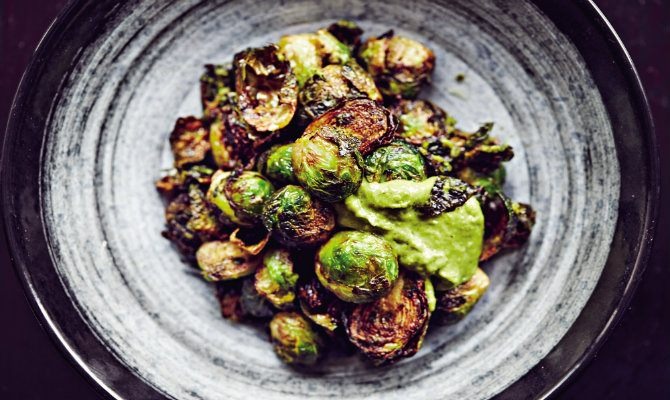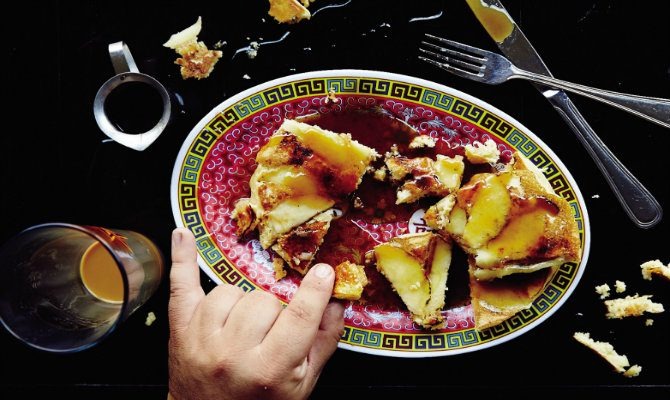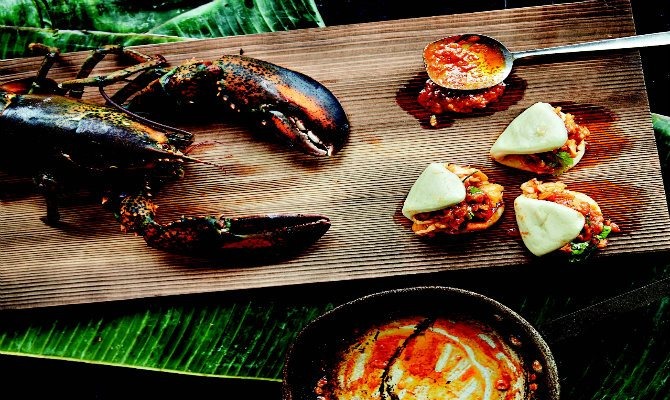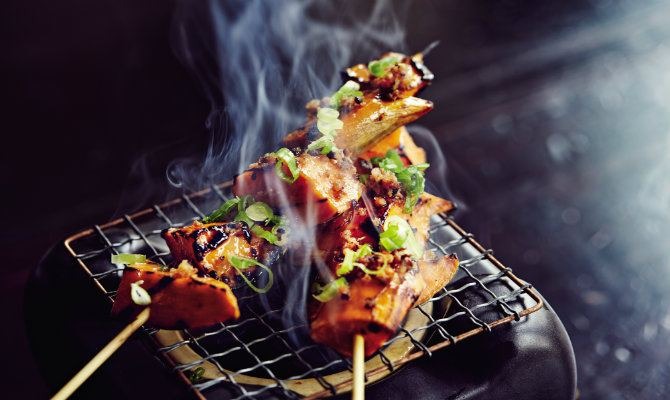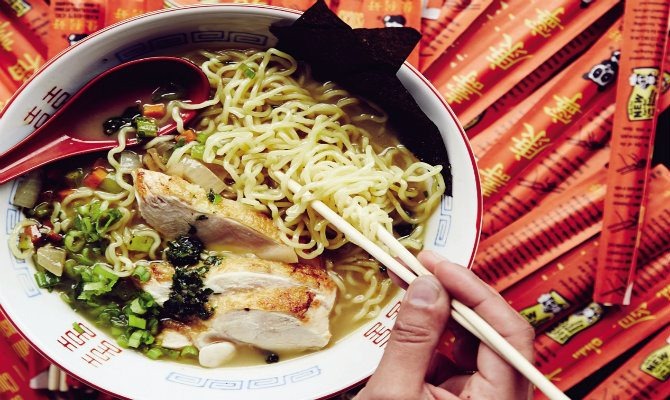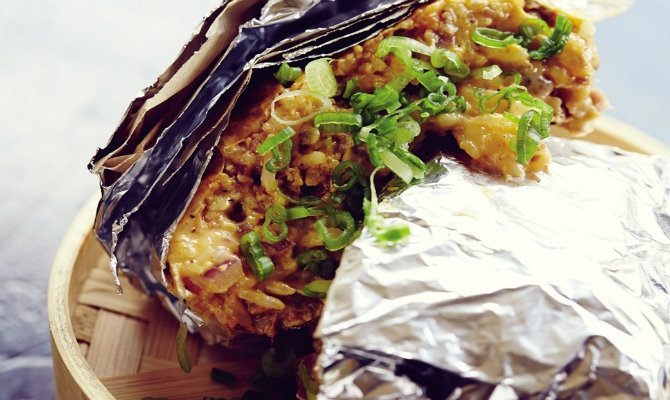Dale Talde Talks About The Inspiration For His New Cookbook 'Asian-American'
A gold Jesus chain hangs from a lobster's neck in the front cover of Dale Talde's new cookbook, Asian-American. It's a symbol of what's to come as you flip through the pages of recipes — recipes only Talde could produce.
Somehow he captures the essence of his cultural background: the influence of his Brooklyn neighborhood seeps into classic Asian cuisine in dishes like his Pretzel Pork-and-Chive dumplings and Miso-Marinated Salmon, Reuben Style. He gives a nod to his love of cheap American food with his Pepperoni-Pizza "Very Warm" Pockets, stating, "You may front like you never liked Hot Pockets. But if you grew up in the 80s, you know you did."
The book is light-hearted, and acknowledges that these foods aren't about molecular gastronomy or the overly-fussy. Although he admits that he puts as much care into his nachos as Eric Ripet of Le Bernardin does his foie gras. It is real food, based on real cultural fusion. While Talde boasts that these recipes are, "proudly inauthentic," they are very authentic to his own identity as a Pilipino-American, who grew up in Chicago, moved to Brooklyn, and embraced every bite of food he ate along the way.
We had the opportunity to talk to Talde about his inspiration, food, and cultural fusion.
This interview has been edited for clarity and organization.
The Daily Meal: What is your philosophy on cooking? Where do you find your inspiration?
Dale Talde: I don't know if I have a philosophy. I like tasting food. I used to think aesthetically I wanted it to look like x, y, and z; but now, I am more interested in making really good tasting food. I'm not caught up with authenticity at all I just grab from wherever. I've never been a chef who just uses five ingredients; it doesn't have to be that simple, but I do like simple preparation. My philosophy changes every day — moment to moment.
A lot of people I know are cooking food really gently; I am the opposite of that. I had to have special wok burners put in at my restaurant that are hotter. Cook it as hot as it can get.
TDM: You describe the recipes in this book as "proudly inauthentic," what role does cultural fusion plays in your cooking?
Cultural fusion, to me, is everything; It's who I am. I am a Pilipino-American; Chicago-raised, but living in Brooklyn now. Culture is all around you: pop culture, religious culture, the culture of a city or state. I think my biggest thing is being influenced by my day to day interactions, things I pass on my walk to work.
Growing up one of my friends never had a home-cooked meal, and I thought it was so cool [his mom] gave him 40 bucks to go eat. I wished my mom would do that for me. My cooked every day, sometimes she cooked twice a day. When I was growing up more than anything I wanted that cheeseburger meal with the toy inside, and I wanted to jump in that crazy, dirty ball pit— that's what I wanted.
TDM: Can you elaborate on how your environment directly affects the food you choose to make?
It is everything from the pizza shop at 4 am to eating Korean food at my in-law's in Brigham County to eating chicken and rice from a Halal cart to eating clams on the Jersey Shore. Brooklyn specifically: Brooklyn's Chinatown, Sunset Park's Mexican food, the great Italian-American culture in Brooklyn – that is where I pull my inspiration from for the Brooklyn restaurants.
TDM: How did these experiences influence what recipes you chose to include in Asian-American?
I had never had a Connecticut Lobster Roll before I moved to New York City. That was the influence for the Lobster Bao recipe. It is butter based, not mayo. Then there is the pastrami spice miso-marinated Reuben-style salmon in the book; I live next door to Junior's and it is one of the best pastrami sandwiches around. I will say on a whole the Reuben is one of the best sandwiches.
TDM: How do you think this idea of cultural fusion changing or blurring the lines around what we define as "American" food?
I think cultural fusion is happening every day, sometimes by accident. An influx of immigrants are coming here, and they can't get what they used to buy in their home country, and are making do with [the foods] they can find in grocery stores here. I think it's a beautiful thing.
For example, my wife makes her own kimchee at home, and I like eating Spam with kimchee. I like making Spam fried rice, so now I'm making Spam and kimchee fried rice.
My wife did something that was just the quintessential [example of fusion]. She ate at [Peter] Lugers, took home her leftovers, and with that butter they pour on the steak made fried rice, kimchee, and the Luger steak. One it was amazing, but that is exactly what we are talking about here. In Korea it would be the steak and soy sauce, no dairy. Now, she has taken something so stereotypical Brooklyn — I mean what's more Brooklyn than Peter Lugers? And just because she ate there, and came home and had kimchee and rice in her fridge she is making this thing that crosses cultures. Would Koreans make short rib, kimchee fried rice? Of course they would, but would they take a T-bone cooked in butter, medium-rare, and make fried rice out of it? No.
We take inspiration from wherever and however you are eating. When I'm in Miami I am drinking a Cuban espresso and watching Cuban sandwiches be pressed; when I'm in Chicago I'm eating gyros at my favorite gyros joint; I love soaking it in, food is the ultimate for me, I am always thinking about it.
TDM: Is there anything else you want to tell us about the book?
I hope people get it, like it, and don't take it too seriously. Maybe [readers] will see that there is a new generation of people coming up. This is how I see America, and the world. It's not black and white. It's black and white and Asian and Latino; It's Muslim; it's Christian, and Jewish. We can make fun of it because we are going through it. Growing up I was a Pilipino-American kid, but to the Pilipino community I wasn't Pilipino. To the American community I was just some non-descript Asian kid.
TDM: What do you hope readers get out of this book?
I don't want anyone to read too much into it. I hope they read it. I hope people understand some of that 90's side-culture. I don't mind if someone reads this, and thinks, "I don't need to make fried chicken, because Popeyes is dope, I am going to make this other dish because it's really simple to make."
I don't want people to over think what this book is. This food is elegant, to me, but so is a plate of nachos.
Want to try a recipe?
#369 Brussels Sprouts with Green Sambal
This blows the standard sprouts with garlic and bacon out of the water. I'm not hating, just saying. Roasting the sprouts at a high heat brings out their sweetness and crunch, and green sambal acts like Southeast Asian pesto, coating each one with its smack-you-in-the-face herbaceousness. I call it #369 to honor Talde's address at 369 7th Avenue as well as the brilliant tradition of ordering from Chinese menus by number. — Dale Talde
For the #369 Brussels Sprouts with Green Sambal recipe, click here.
Apple Pancakes with Five-Spice and Coconut–Brown Butter Syrup
Apple pancakes are the first dish I ever cooked and my first form of culinary rebellion. I was nine years old, scrawny, and just over four feet tall. Mom had made sinigang—again. I was usually down with this tamarind-based Filipino soup. Sometimes, though, I'd get tired of it, like white kids probably get tired of yet another meat loaf. "I'm not eating that," I told her. "I want apple pancakes." Apple pancakes might be the polar opposite of fish-head sinigang. — Dale Talde
For the Apple Pancakes with Five-Spice and Coconut–Brown Butter Syrup recipe, click here.
Bao-ed Lobster in Warm Chile Butter
I have no loyalties when it comes to lobster rolls. If you pile sweet chunks of crustacean on a bun, I'm sold. Yet there's something about the Connecticut style—warm, buttery lobster as opposed to the chilled mayo-coated Maine style—that gets me particularly amped. Purists, look away: I use scallion, cilantro, and Sriracha in my version. For anyone who thinks Sriracha is played out, I dare you to taste what happens when it gets mellowed with butter and brightened with lemon juice. Chinese steamed bao buns provide a slightly sweet, doughy backdrop similar to the classic split-top bun. — Dale Talde
For the Bao-ed Lobster in Warm Chile Butter recipe, click here.
Grilled Sweet Potatoes with Soy Sauce, Maple, and Bacon
My mom only ate sweet potatoes for dessert. She'd throw one in the microwave and dig in. No butter, no sweetened condensed milk, nothing. I kept telling her, "Mom, that's not dessert, that's a potato." For a while I thought this reflected our cultural divide. She grew up in the Philippines, where inherently sweet ingredients like corn went into desserts. I grew up in Chicago, where corn was buttered and salted and beans went into burritos. But when I started working in restaurants during Thanksgiving, I saw what the white boys and black guys I worked with made, and I was confused all over again. As I watched them pile the brown sugar and marshmallows on sweet potatoes, I was thinking, "That's just pie without the crust." — Dale Talde
For the Grilled Sweet Potatoes with Soy Sauce, Maple, and Bacon recipe, click here.
Roast-Chicken-Dinner Ramen
A good roast chicken is one of the best things you can put in your mouth. And ramen? It should officially replace chicken noodle soup as the most comforting food on earth. Together, they make magic: the undeniably awesome aroma of a bird roasted with garlic, thyme, and sage infused into an umami-packed broth teeming with addictively chewy noodles. Because the dish is essentially just a really good chicken soup, I'd happily eat it with any noodle, from the proper ramen.
Sausage, Egg and Cheese Fried Rice
The sausage, egg, and cheese on a roll is one of those iconic New York foods that, unlike pizza slices, bagels, and dirty-water dogs, you only really get to know if you live here. In that way, it's like the bodega itself. In fact, the moment I felt like I'd become a real New Yorker was the night I rolled into my bodega and the guy behind the counter finished my order for me. I go, "Sausage, egg, and cheese ..." And before I could finish, he chimes in "... salt, pepper, extra ketchup."
For the Sausage, Egg and Cheese Fried Rice recipe, click here.
Click here for more recipes from cookbooks.
Angela Carlos is the Cook Editor at The Daily Meal. Find her on Twitter and tweet @angelaccarlos.
